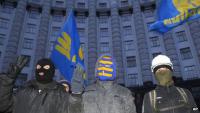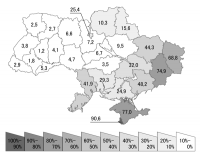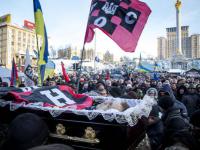Huge protests have rocked Ukraine since November. Kiev’s main square has been occupied, there have been dramatic scenes of heavy fighting between militant protestors and police, and government buildings have been stormed and occupied too. But it was the fascist flags that first caught my eye when the protests escalated suddenly to draw in hundreds of thousands in the first days of December.
Many reports were accompanied by pictures like the one above, an AP photo that appeared on the top of a Guardian piece (where it has since been replaced) and in this BBC report.
They didn’t mention that the flags with the three-fingered logo are those of the fascist Svoboda party.
This does not mean that all or most of the protestors are fascists. But it was clear from pictures coming out of Ukraine that the fascists had an open and sizeable presence in the protest, and this was accepted by the mass of the movement.
Since then, the fascists have gained alarmingly in strength and influence, by taking the lead in some of the most militant actions. Hard-core fascists have been at the heart of the occupation of Kiev city hall and the heavy fighting against the police at the barricades of Hrushevskoho street.
What’s happening?
So what is going on? There have been differing interpretations on offer.
• Much of the mainstream coverage in the Western media, in line with EU and US politicians, has been sympathetic to the “Euromaidan” protests which began when Ukraine’s president Victor Yanukovych pulled out of signing an association agreement with the EU at the eleventh hour.
EU ministers, including British foreign secretary William Hague have backed the pro-EU protestors as fighters for democracy against Yanukovych’s pro-Russian government. US Secretary of State John Kerry has weighed in too.
• Not all commentators have fallen in behind this line, however. In a Guardian columnSeumas Milne pours scorn on these arguments, pointing to the strategic interests of the EU and Nato in the Ukraine, as well as the presence of the fascists.
Milne is not uncritical of Yanukovych and speaks out against the government’s repression. He does not ignore the anger and frustration in Ukraine at poverty, inequality and political corruption.
But his piece concentrates its fire on Euromaidan and its western backers. He concludes with a warning about the dangers of “outside interference” in Ukraine, a warning clearly directed at the Western powers rather than Russia. In this he echoes Russian president Putin.
• Elsewhere, some on the left have identified the protests as part of the anti-capitalist movement. The huge protests in the main square of the capital and the fighting with police look familiar.
I disagree with all three of these positions. Here’s why…
Oligarchy
The real divide reflected in these protests is among Ukraine’s ruling class. Ukraine is an oligarchy: a small number of very rich and powerful people control huge swathes of the economy – and many of its politicians.
That oligarchy is divided between those whose interests lie with the EU and those who profit from close ties with Russia. Coverage of the oligarchy has focused mainly on those pulling strings with the Yanukovych regime. But the pro-Euro side has its oligarchs too.
One example is Yulia Tymoshenko, the jailed leader of the conservative Batkivshchyna (Fatherland) party, the largest involved in the protests. Tymoshenko set up a gas company that at one stage controlled up to one fifth of Ukraine’s economy.
Neither bunch of oligarchs has the interests of ordinary people in Ukraine at heart. Nor do the EU and Russia, the big powers hovering on the borders who are assiduously courting the oligarchs and the main parties.
Euromaidan – with its key demand the signing of the association agreement and alignment of Ukraine with the EU – is in effect a mass mobilisation behind a faction of the ruling class.
Ukrainians urging a tie-up with the EU could usefully have a look at the experience of workers actually in the EU – for example in Greece, where the Euro-regime has brought abject misery.
When Tory William Hague and his counterparts across the EU cry out in support of protestors, when German chancellor Angela Merkel’s Christian Democratic Union is in alliance with the two largest opposition parties involved, alarm bells should ring.
I don’t think people on the left should fall in behind the politicians and the press who urge the integration of Ukraine with the EU and lionise the pro-EU protestors as offering the true route to prosperity and democracy.
Workers divided
Nor does Euromaidan unite workers in Ukraine. The protests, like the votes for the opposition parties at election time, mobilise mainly those from western and central Ukraine. Those in the south and east of the country vote heavily for Yanukovych’s pro-Russia Party of the Regions and have shown little support for Euromaidan.
There is a faultline between the two halves of Ukraine. In the country as a whole up to 40% of the population is primarily Russian speaking. Another 5% speak other minority languages. The Russian speakers are concentrated in the southern and eastern parts, while those whose first language is Ukrainian are mainly in the western and central areas.
Distribution of heavy industry, employment levels and wage rates also vary between the two halves of the country. There are different histories – and views of history – on both sides too. The economy in the southern and eastern parts is more closely tied to Russian industry.
Neither half of the country is itself homogenous. But this unofficial divide, and the relatively even numbers, help explain why politicians on each side have taken turns in power (with and without vote-rigging – corruption and the huge influence of the oligarchy is a big problem in Ukraine).
2004’s so-called “Orange Revolution” – like Euromaidan, drawing its support mainly from western and central Ukraine – brought down Yanukovych, whose election victory had been rigged. A pro-West regime moved in. But in the 2010 elections, which observers considered acceptable, he was returned to power.
I think there is a problem with a movement that aligns itself with one wing of the ruling class and, at the same time, cuts itself off from a huge section of the working class that identifies its interest with that of “its own” faction, the pro-Russia one.
Russia
Russia has long-term strategic and economic interests in Ukraine and has been sounding off in support of Yanukovych’s government.
Just to make it clear: I don’t support a pro-Russia position either, and not only because of the appalling repression meted out by government forces.
Seumas Milne is noticeably more keen to warn of the dangers of Western alignment and point to (real) flaws in the protest movement than to look too closely at the problems with the pro-Russia faction, although in fairness he doesn’t avoid the issue of the government’s corruption or violence.
But his attack on EU and NATO manoeuvrings is not matched by a similarly harsh analysis of Putin’s stick-and-carrot endeavours.
And when he criticises the oligarchy, he does so with what I think may be a little tear of regret in his eye for the old Stalinist USSR. The oligarchs “privatised” state companies after the demise of the Soviet Union and made a fortune, he says.
Indeed they did. But Seumas can’t kid us that the pre-privatisation Stalinised state was run in the interests of the workers – it exploited them ruthlessly, just as workers were exploited in the West and are now exploited in today’s Ukraine.
I’d rather adapt an old slogan slightly and say: neither Brussels nor Moscow.
Anticapitalism?
I’ve seen some commentary on the left describing Euromaidan as an anticapitalist protest. But this is not an anticapitalist, anti-austerity movement or even one around working class demands.
It’s true that general discontent and anger over falling standards of living and endemic corruption play a part in the protestors’ readiness to turn out. Anger at police violence has also been a factor.
It is quite right to oppose police violence, state repression and anti-protest laws – whether in Ukraine or elsewhere. No-one, regardless of their views on the EU or anything else, should support Yanukovych’s crackdown.
And the Euromaidan movement is not wholly controlled by the three opposition parties – Tymoshenko’s Fatherland, the Ukrainian Democratic Alliance for Reform (known as UDAR, which means “punch”) led by boxer Vitali Klitschko, and the fascist Svoboda party headed by Oleh Tiahnybok.
But the protest movement is not raising its own demands, independent of those of the pro-Europe political leaders or the oligarchy behind them.
If this movement raised anticapitalist slogans, attacked the profiteering oligarchy or even raised working class demands – higher wages, anyone? – it might break out of its western-central heartland and unite the mass of ordinary people across Ukraine. And it might give both sides of the oligarchy a serious scare.
But there is no sign that it is doing any such thing.
And the fact that the movement as a whole has accepted the presence and role of fascists in its midst – and that sections of it have applauded the hard-core nazis involved in the heaviest fighting – really is disturbing. This is certainly not the hallmark of a progressive movement.
Nationalism
Euromaidan is a very flaggy movement. Leaving aside the various fascist flags, and the EU flags that were more in evidence in the early days, the national flag of Ukraine (blue and yellow halves) has been everywhere.
Nationalism colours this movement. It runs from the official opposition parties – “Fatherland”, now there’s a name for an organisation – to the ordinary protestors. Some on the left in Europe have seen this as progressive. It is not.
This is not a fight for independence, national liberation or national rights. It is not analogous with anti-colonial struggles, nor with questions of self determination like that posed by Catalunya inside the Spanish state.
Ukraine is an independent state, with its own capitalist class. Ukrainians – whether defined by citizenship, ethnicity or language – are not oppressed as Ukrainians inside Ukraine.
Instead, Ukrainian nationalism plays a reactionary role, and helps reinforce divisions inside Ukraine’s working class. And the dominance of “softer” nationalist ideas provides a feeding ground for the fascists – whose ideology is based on a hard-core nationalism.
The fascists
Fascism in Ukraine has followed the traditional twin-track strategy of having both an electoral and a paramilitary or streetfighting wing. Svoboda (“Freedom”), the main Ukrainian fascist party, was set up in 1991 under the more revealing name, Social-National Party of Ukraine. It used the Wolfsangel symbol beloved of Nazis everywhere and had a paramilitary wing, Patriots of Ukraine.
In the middle of the last decade, the party went down the Eurofascist route pioneered by the French Front National and later adopted by the British National Party, and did a clean-up. It formally dissociated itself from the paramilitaries (while maintaining quieter relations in the background) and dropped the Wolfsangel for the cheery three-fingered flag.
Svoboda has observer status in the Alliance of European National Movements with the BNP, Hungarian nazis Jobbik and the French FN. It is thought to have had around 15,000 members by 2010.
Svoboda won 10.4% of the vote in the 2012 parliamentary elections, largely concentrated in western Ukraine where it took up to 40% in some areas (compared with 1% in eastern Ukraine).
That 10.4% is well above the 6.9% scored by Golden Dawn in Greece, and Svoboda now has 36 MPs. Shortly after the election, it became part of a formal three-way opposition alliance with Tymoshenko’s Fatherland and UDAR.
These are the opposition parties leading the Euromaidan protests, and the tripartite alliance has normalised Svoboda’s role. “Platform” doesn’t do justice to Svoboda’s luxurious position: it gets its name on calls for action, signed by all three leaders, as part of this alliance. Tiahnybok is an equal partner in the opposition’s negotiations with the government. He is widely quoted in the media as a “nationalist” leader.
In these circumstances, it is perhaps not surprising that the fascists’ presence in the protests has been accepted.
Paramilitary
Svoboda’s position also provides cover for other fascist groups, among them the UNA-Ukrainian National Self-Defence (UNA-UNSO), a substantial paramilitary nazi organisation, and the hard-core groups of the “Right Sector”.
Some use the flag of red and black halves that can be seen in the protests. Sadly this is not an anarchist flag. It echoes the colours of the wartime Ukrainian Insurgent Army, the military wing of Stepan Bandera’s OUN-B organisation, which was originally allied with the Nazis and many of whose troops were trained in Ukrainian battalions attached to the Nazis’ forces.
A key development has been the fascists’ leadership of the most militant protest actions – this has won them greater support.
Photographs inside and outside the occupied Kiev city hall show Svoboda and other fascists in control, and using it as a base to train the helmeted fighters. The “defence” squads that have battled police – with Molotov cocktails at the barricades – are led by the fascists, who of course bring their paramilitary and streetfighting expertise to the party.
Of the three protestors killed by police at Hrushevskoho street in January, the death of one – Roman Senyk – was announced by a Svoboda MP.
A second, Mikhail Zhiznevsky, was a member of the UNA-UNSO and was given a full paramilitary funeral as well as being paraded through the Euromaidan protest in an open coffin draped with the UNA-UNSO’s distinctive red flag with “cross potent”, which seems not to have raised any eyebrows. The third appears to have been an Armenian nationalist.
In this way the fascist groups have become not merely accepted, but widely respected and admired as the bravest and most militant “activists”. Svoboda and the other fascist groups have been able to use this prominent role to win recruits, build their organisations and increase their influence.
Conclusion
The fact that economic misery, hatred of corruption and anger at the government are part of many people’s motivation for joining the protests does not in itself make the movement progressive. Nor do the forms of protest – occupying squares and buildings, fighting the police – make it so.
Where there is no left wing or working class response to austerity or political corruption, people’s discontent and anger can be channelled in a very different direction and other forces can grow in the vacuum.
Whatever happens to the Euromaidan protest, one thing is clear. The fascists will emerge with much stronger, more confident and better rooted organisations.
Source: http://www.dreamdeferred.org.uk/2014/02/ukraine-the-protest-movement-and-the-fascists/





Perspectives of social struggles?
Thanks for the posting.
This is all ugly. and fascists are also recognised by their deeds, behaviour, their actions.
Question:
What can those folks do, who want to better their living conditions?
Social Protest was the beginning, was it?
FSB-allies are not an alternative.
Putin has visited Victor Orbán in Hungaria.
What chances do the progressive poor have, in direct actions, parties, betterments?
yes
vielen dank für diesen artikel --- ähnliches berichten auch anarchosyndikalisten aus der ukraine . gleichzeitig weisen sie aber daraufhin, daß in anderen städten es durchaus noch zu sozialen protesten gegen regierung und eu - getragen auch von vielen linken --- kommt, wo die nazis noch nicht die kontrolle haben - charkow z.b.
An interview with members of Antifascist Action
An interview with members of Antifascist Action Ukraine
http://www.timothyeastman.com/uncategorized/an-interview-with-mira-andre...
Tash Shifrin
Hallo, ich bin die Person, die diese Geschichte geschrieben hat. Wenn Sie sich zu kopieren und hier, bitte können Sie sicherstellen, dass Sie meinen Namen an der Spitze und stellen Sie sicher, dass der Link auf die Quelle ist live und tatsächlich eine Verbindung zu unserer Website Dream Deferred. http://www.dreamdeferred.org.uk/2014/02/ukraine-the-protest-movement-and...
Ich freue mich für euch die Geschichte zu reproduzieren, und ich bin froh, dass die Menschen es lesen, aber es ist nur fair, dass Sie den Schriftsteller gutschreiben und verbinden die Blogs, die Sie Material aus nehmen.
Vielen Dank und Solidarität.
tash
Please make sure you credit me and link my blog
Hi - as you can probably guess from the comment above, I can't speak German.
But I am the person who wrote the story you have reproduced here. You have copied and pasted it without my name as author and although you have given the source, it is not a live link.
I am happy for you to reproduce the story, and for people to read it here. But please can you edit it to include my name as the writer and link my blog with a LIVE link that actually connects to the website Dream Deferred. It is only fair to credit the people you take material from.
http://www.dreamdeferred.org.uk/2014/02/ukraine-the-protest-movement-and...
Thanks and solidarity
tash
PS, if you want to get in touch, you are welcome to contact me through the site's contact page or via @dreamdef1 on twitter
done
Hi,
I set the authoring information to Tash Shifrin. The link should be live as well. I hope you're happy now.
Thanks and soildarity